| Srl | Item |
| 1 |
ID:
070071
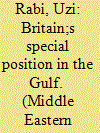

|
|
|
| 2 |
ID:
154239
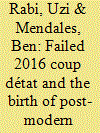

|
|
|
| 3 |
ID:
082004
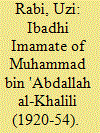

|
|
|
| 4 |
ID:
053292


|
|
|
| 5 |
ID:
111189
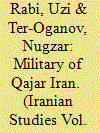

|
|
|
|
|
| Publication |
2012.
|
| Summary/Abstract |
The article examines the parameters of the irregular army in Qajar Iran, including its assembly, numbers, and provisions, as well as the army's organizational structure: its administration and the divisions of the ad hoc forces (provincial militia and tribal cavalry) and of the standing forces (the shah's bodyguard and artillery corps). Until the creation of the so-called regular army units in Iran at the beginning of the nineteenth century, the irregular army was regarded as the only military force in the service of the Qajar dynasty. Despite the existence of a "regular army," irregular forces, particularly tribal cavalry, continued to play a significant role in Iran's military system throughout the nineteenth century. By understanding the features of the irregular army-its role in Qajar society, its organizational and social structures, its ethnic composition, and other characteristics-we can better understand the character of the state itself.
|
|
|
|
|
|
|
|
|
|
|
|
|
|
|
|
| 6 |
ID:
064749
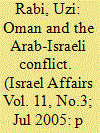

|
|
|
| 7 |
ID:
089644
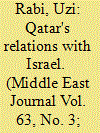

|
|
|
|
|
| Publication |
2009.
|
| Summary/Abstract |
This article focuses on the development of Qatar's unique relationship with Israel, and explains the relationship as just one component of the Emirate's intricate and bold foreign policy. This discussion identifies both the logic behind Qatar's regional policy initiatives as well as the Emirate's ability to adapt to changing regional and international circumstances. As such, this article provides an example of how a small, wealthy state like Qatar can skillfully generate a sophisticated, independent foreign policy agenda that differentiates itself from its larger and influential neighbors, while simultaneously upgrading its international profile and gaining regional prominence.
|
|
|
|
|
|
|
|
|
|
|
|
|
|
|
|
| 8 |
ID:
089060
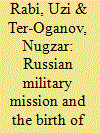

|
|
|
|
|
| Publication |
2009.
|
| Summary/Abstract |
Throughout the nineteenth century, the Qajar dynasty (1797-1925) of Iran engaged in a continuous process to build a regular army under the leadership and tutelage of professional European military missions. These continuous attempts at military reform and Europeanization reached a peak with the creation of the Persian Cossack Brigade (1879-1921) by the Russian military mission. This article focuses on the genesis of the Brigade and the Russian military mission, which followed some of the previously unsuccessful European military missions. The scholarly literature has paid little attention to the fitful beginnings of the Brigade. This article, however, deals with the early challenges faced by the Brigade during the period between 1879 and 1894, at the end of which it was on the verge of dissolution. The article tackles formative issues raised in under-explored Russian archival material and supplemented by Russian-language primary sources, as well as other relevant sources. It attempts to re-evaluate the origins of the Persian Cossack Brigade and provide a well-balanced portrait of the Brigade in light of the changing regional politics of the period.
|
|
|
|
|
|
|
|
|
|
|
|
|
|
|
|
| 9 |
ID:
155278
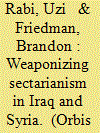

|
|
|
|
|
| Summary/Abstract |
The last six years of insurgency, rebellion, and war have eroded territorial state sovereignty in Iraq and Syria. The scale and savagery of the war have transformed Sunni-Shia sectarianism into a zero-sum politics of survival. In other words, residents of Iraq and Syria have been forced to choose between Sunnis and Shia in order to survive. This essay explains how the diverging interests of foreign actors—Iran, the Islamic State and other Salafi-Jihadi foreign fighters, Russia, Saudi Arabia, Turkey, and the United States—prolonged the war, providing the time and space for the belligerents in Iraq and Syria to weaponize sectarianism.
|
|
|
|
|
|
|
|
|
|
|
|
|
|
|
|